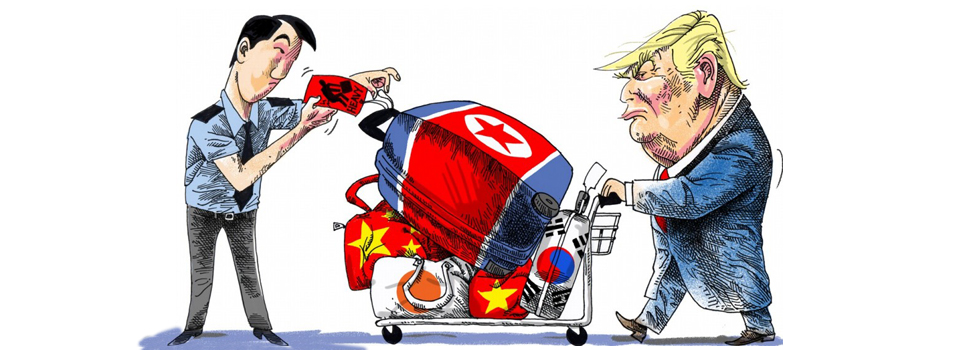It is an ambitious trip. He will stop in Japan and South Korea, two US allies, and China, by far the most important Asian country for Washington. In Da Nang, Vietnam, he will attend the Asia-Pacific Economic Cooperation summit, and in Manila, he will attend a gala dinner to mark Asean’s 50th anniversary. Taken together, these destinations and occasions are a cartographic representation of key US interests in Asia. The question is how Trump will use his visit to underline American commitment to the region.
Asians will ask for different things from him. For South Korea, the agenda is assured. North Korea’s nuclear and missile provocation has risen so high on the radar of American patience that the danger is not that Trump will do too little on that front but perhaps too much. There is a danger that Pyongyang will overshadow his entire Asia trip.
Indeed, his stance on North Korea will be welcomed in Japan as well, since it lies in the immediate path of Pyongyang’s missile tests. It would not be going too far to say that Tokyo would benefit from a public declaration of Washington’s strategic bottom line as much as Seoul would.
As for China, it finds itself sandwiched between American insecurity vis-à-vis the North Koreans, and its own balance-of-power compulsions with Washington. America knows that there is a limit to Beijing’s ability to influence Pyongyang’s nuclear and missile programme. For North Korea, that programme is key to its regime’s survival. On this issue, it will not heed China’s constraining voice any more than it will be swayed by America’s threats.
Thus, it would be a pity if Trump’s trip to Beijing were to be hijacked by Pyongyang. Instead, frank, behind-the-scenes talks with President Xi Jinping on Asia’s strategic future would do much to tell the Chinese what the stakes really are. Buoyed by their economic growth and military prowess, the Chinese are in some danger of forgetting that, while they are Asia’s pre-eminent power, the Americans are the world’s. That includes the Indo-Pacific region that stretches from the shores of the US to those of India. Australia, Indonesia and Vietnam which are very much a part of that region.
If the Chinese really are worried about the Americans building a ring of military, diplomatic and political containment around them, Xi should give Trump some reasons why Americans should treat Chinese as partners and not rivals.
This is where the Association of Southeast Asian Nations enters the picture. Northeast Asia is not the only theatre of America’s engagement with Asia: Southeast Asia complements that subregion as an intrinsic part of the Indo-Pacific landscape. If the Korean war helped determine the US posture towards Northeast Asia, the Vietnam war was even more important: it clarified America’s self-perception as a Pacific and, indeed, global power. During the cold war, particularly when China and the Soviet Union were on the same side against the US, it was Asean’s emergence in 1967 that solidified America’s position against Soviet and Chinese encroachment into Southeast Asia.
Today, Asean unifies both its founding non-communist members (and Brunei and Myanmar, which joined later) and the former communist countries of Southeast Asia. It can contribute to stabilising the balance of power between the US and China, and between China and India. None of these three powers can take Asean for granted.
Asean’s Manila conclave will mark 50 years of survival of perhaps the most resilient regional organisation in contemporary history after the European Union. However, unlike the latter, which is overstretched by its overreach into the internal affairs of its constituents, as Brexit proves over European immigration into Britain, Asean knows where to stop before its efforts at integration begin to fray.
Trump would do well to underline Asean’s place in the American world order, which he no doubt wishes to sustain in the face of China’s (and India’s) rise, and the intransigence of Russia.
Russia, it must not be forgotten, is a nuclear Eurasian power and not only a European one. A new Beijing-Moscow axis would recreate America’s cold war nightmare. Washington would need friends. Asean was one then; it still is.
America’s decision to pull out of the Trans-Pacific Partnership, which would have established its leadership of a globalising world, was a casualty of the defensive economic nationalism that brought Trump to power. That is a done deal. What remains is for the US to reassert its leadership of Apec, whose 21 economies accounted for almost 60 per cent of the world’s gross domestic product and nearly half of global trade in 2015.
What Asians need to know is how America wishes to play its role in a globalising world. Surely, the president of the world’s most powerful nation sees that there is no politics without economics.
America’s leadership of the free world after 1945 was premised on how nations flourished in a liberal internationalist order that tied them to the political interests of the US. Economic protectionism leads to political isolationism. Trump could try to reassure Asians that his country remains committed to playing its role. Apec is a vehicle that cannot be ignored.
At the moment, it is not policies but principles that Asians are looking for. His visit should help to put their doubts at rest – or else tell them that America is just another country now and that other nations should make themselves home in another world.

